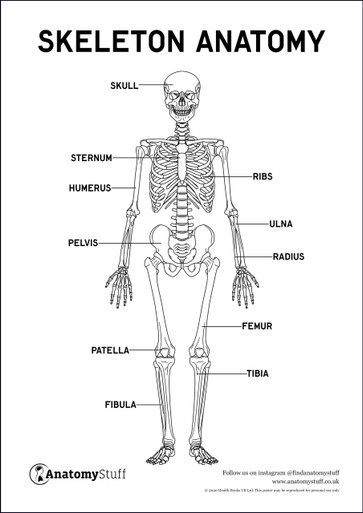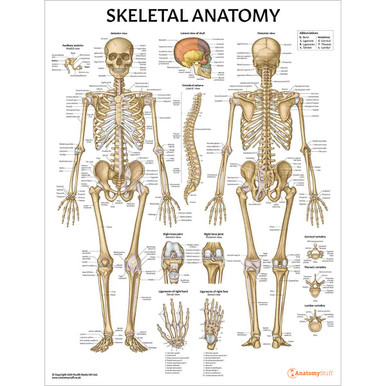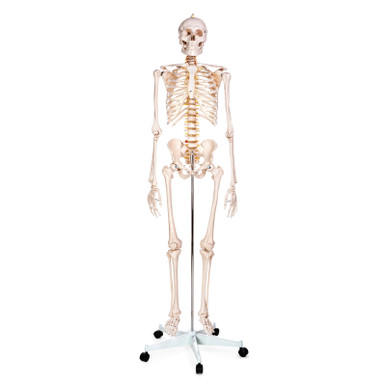Written by: Liz Paton, MSc
Skeleton Anatomy Overview
The human skeleton is the foundation of our body. It enables movement, stores minerals, makes red blood cells, bears our weight and provides support and protection for our internal organs such as our brain, lungs and heart. The skeletal system consists of the bones ligaments and cartilage that make up our internal framework.
Bones of the Skeleton
The human skeleton is a system of bones that holds the body together. The adult human skeleton is made up of 206 bones. Infants are born with about 300 bones mostly made up of cartilage, which turns into bone during a process called ossification.
Bone Structure
The outer surface of bones is called the periosteum, a dense membrane of vascular connective tissue that nourishes the bone. Next is a hard layer called compact bone (also known as cortical bone). This is the smooth surface that you see when you look at the skeleton. The next layer is cancellous bone (often referred to as spongy bone due to its spongy appearance) which is made up of groupings of trabeculae that provide structural support and strength. Bone marrow is a thick, jelly-like substance found in the centre of most bones that contains stem cells which can turn into red blood cells, white blood cells, and platelets.
Types of Bone
The different types of bones include flat, long, short, irregular, sesamoid and sutural bones.
Flat bones are made up of cancellous bone sandwiched between two layers of compact bone and are flat as their name suggests. Some examples of these bones include several of the bones of the skull, the sternum and ribs, the pelvis, and the scapula. These bones protect internal organs.
Long bones are typically found in the appendicular skeleton and their name speaks to their appearance, with a shaft and two ends. Some examples of these bones include the femur, tibia and fibula, metatarsals and phalanges, the humerus, ulna and radius. Long bones provide structure, mobility and strength.
The irregular bones vary in shape and consist of thin layers of compact bone surrounding cancellous bone. The vertebrae consists of 33 irregular bones which protect the spinal cord. The sacrum, coccyx, sphenoid, zygomatic, maxilla, and hyoid bones are more examples irregular bones.
Sesamoid bones are round bones embedded in the tendons of the hands, knees, and feet that function to protect tendons from wear and stress. The patella of the knee is an example of a sesamoid bone.
Sutural bones (also known as Wormian bones and intra-sutural bones) are the accessory bones (extra bone pieces) that occur within the sutural joint of the skull.
The bones are grouped in two divisions called the axial skeleton and the appendicular skeleton.
Axial Skeleton
The axial skeleton is made up of 80 bones and forms the vertical axis of our body. This includes the bones of the skull, vertebral column, and rib cage.
Appendicular skeleton
The appendicular skeleton is made up of the remaining 126 bones of the body and appends to the axial skeleton. This part of the skeleton facilitates movement and it consists of the bones of the shoulder girdle, the upper limbs, the pelvic girdle and the lower limbs.
Joints and Motion of the Skeleton
A joint is where two or more bones meet and allow movement. They can be classified by their structure or by their function.
Functional classification is based on the type of joint movement: synarthrosis (immovable), amphiarthrosis (partly movable) and diarthrosis (movable joints). Structural classification is based on the three tissue types that make up the joint: fibrous, cartilaginous or synovial joints.
Synarthrosis joints include fibrous joints; an example of this include the sutures of the skull, such as the coronal suture. Amphiarthrosis joints include cartilaginous joints; an example of this includes the pubic symphysis, a slightly mobile joint that unites the bones of the hip with fibrocartilage. Diarthrosis joints include synovial joints; examples of these joints include the shoulder and elbow joints.
Synovial joints can be broken into more categories based on the shape and structures of the joints. These include pivot joints (such as the atlas and axis of the neck), hinge joints (such as interphalangeal joints, the knee, and elbow), saddle joints (such as the carpometacarpal joint of the thumb), plane joints (such as the carpals of the hands and tarsals of the feet), condyloid joints (such as the radiocarpal joint) and ball-and-socket joints (such as the shoulder and hip joints).
Ligaments of the Skeleton
The skeletal system consists of more than just bones. The skeleton consists of approximately 900 ligaments. Ligaments are fibrous, tough, flexible, rope-like connective tissues that connect and stabilise joints, often named from the bones which they attach.
The ligaments of the skeleton can be broken down into two types: white ligaments and yellow ligaments. White ligaments are made up of inelastic collagenous fibres while yellow ligaments are made up of tough elastic fibres.
Cartilage of the Skeleton
Cartilage is resilient, rubber-like connective tissue that covers the surface of our joints and acts as a shock-absorber, creating a low-friction environment at the end of our bones. Although cartilage is stiff and inflexible, it is not quite as hard and rigid as bone. It is however, significantly less flexible than ligaments and muscles.
Cartilage is found at the end of the bones where joints form. It is also found at the ends of our ribs, in our bronchial tubes and airways, between the vertebrae and spine and in our nose and ears.
The three types of cartilage include hyaline, fibrous and elastic cartilage.
Hyaline cartilage exists around our joints and in the nose, rings of the trachea and the tips of our ribs. Fibrous cartilage is found in the pubic symphysis and in vertebral discs. Elastic cartilage can be found in non-load-bearing parts of the body such as the external ear.
PDF Downloads
View All














